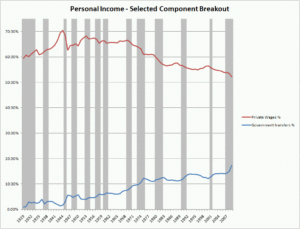While the increasing role of transfer payments to shore up personal income and stabilize consumer spending has long been recognized by the more circumspect economic observers throughout the recent recession and “recovery,” the observation has now gone main stream. Last week, the USA Today ran an article titled Private pay shrinks to historic lows as gov’t payouts rise.
Those questioning the veracity of the term “recovery” as it applies to the current economic situation in the United States (or at least those who question the strength and sustainability of said recovery) point to the fact that absent transfer payments, real personal income is stuck at a trough level.
Why is the source of personal income important? Earned income (from wages or investment yield) allows people to save, invest, and consume. The government can also redistribute a portion of this income to others who are not working so that they too can save, invest, and consume. Absent sufficient tax receipts, the government can borrow money in order to make transfer payments. However, the government can only borrow and transfer for so long. Eventually there needs to be real productive work that can be taxed in order to pay back the debt.
The USA Today article does a great job of presenting the facts and then presenting opinions on the implications of the facts, overtly mentioning the political orientation of the person opining. Talk about fair and balanced.
Paul Van De Water, an economist at the liberal (the USA Today’s word choice, not mine) Center on Budget and Policy Priorities, argues that the system is working as designed – “stimulating growth and helping people in need.” If that is the case, one would expect to be able to look at a historic chart of transfer payments and see them increase during recessions and decrease afterward. 80 years of data show that about half of the time, this is true. However, the same 80-year chart shows a secular increase in the percentage of personal income coming from transfer payments and a mirror-image, secular decline in the percentage of personal income coming from wages.
The rapid rise in gross public debt shows that the latest increase in transfer payments is not being funded from tax dollars, but rather from borrowing. It will need to be paid back.
Keen-eyed readers will note that the current level of gross public debt is not unprecedented. A similar debt spike occurred in the 1940s as the government borrowed money to fund our efforts in WWII. However, some of this spending built infrastructure and manufacturing assets that were later retooled from war use to productive commercial use. One can’t say the same of transfer payments that mostly fund consumption. Perhaps more importantly, the gross public debt in the late 1940s was near an exhaustive accounting of public debt. Today, there is an order of magnitude more debt ($100T) held “off balance sheet” in the form of “unfunded liabilities” for future promised transfer payments.
It is unclear if we have reached a tipping point, but we know for sure we grow closer by the day. Uncertainty abounds – investors must remain nimble.

